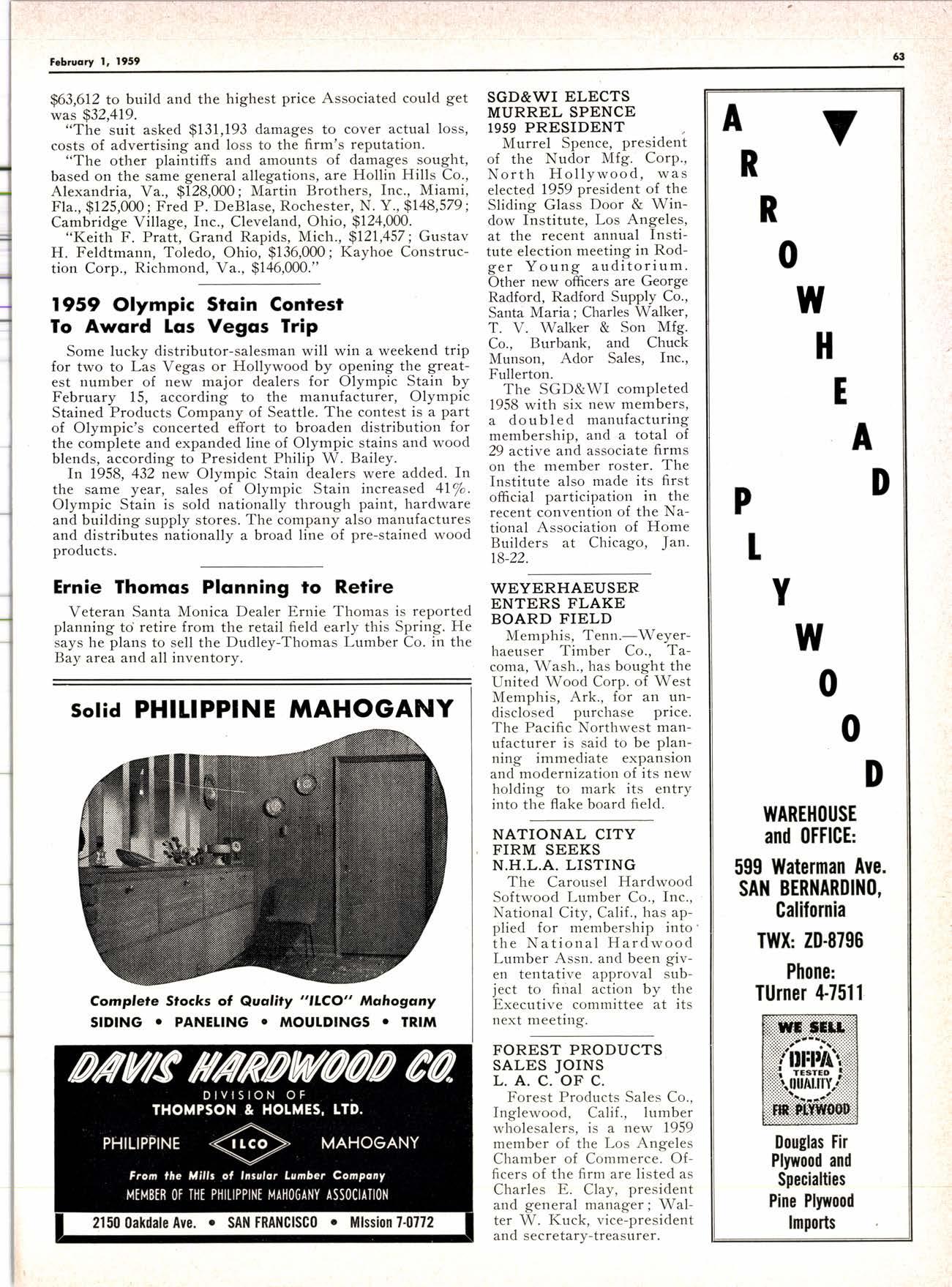
3 minute read
Maple Bros., lnc.
527 Weat Putnam Drlve \^/hlttler' Callfornla' Oxbow A-2536
*Call today lor price inlormation
Dee Essley Sees Dreqm Come True
Prominent Southern California L,umberman D. C. Essley saw a dream of many years come true with the dedication January 11 of the new $3.7 million, 188-bed Presbyterian Intercommunity hospital in Whittier. Wholesaler Essley was a key figure in the ceremonies and was presented a set of special keys in his capacity as president of the hospital board of directors. He worked long and hard in the fund-raising campaign and on construction details. Several thousand persons saw the ceremonies in the hospital's parking lot and heard the blessing by Dr. Eugene Carson Blake, chief executive of the United Presbytbrian Church. The mayor, a supervisor and other civic leaders were in attendance. The four-story, ultramodern facility will serve Whittier, La Brea, Pico Rivera and Santa Fe Springs. The dedication ceremonies were pictured in The Los Angeles Tirnes.
Dee Essley, long the head of D. C. Essley & Son in Los An- geles, started his lumber the industrv notablv for the old California Retail career as a retailer and also served a long spell as secretary-manager of Lun-rber Association.
Sisqlkroft's Miller Retires
After 28 years with American Sisalkraft Corporation, Frank S. Miller, Southern California manager, announced his retirement January 5. Miller has spent his entire career in the California-Arizona building and industrial markets handling the sale of Sisalkraft papers and plastics.
As the pioneer Sisalkraft employee in the Southwest, he has seen American Sisalkraft grow from one representative to thirteen, and a new mill installed at Tracy, California, to service the western states. Miller says that other than enjoying the fishing near his Malibu Lake home, he has no special plans for the near future, reports Philip C. Pendleton, assistant nianager.
NEvqdo 6-0175
PHoNES: ME,"orf o-sg7s
TWX: Compton 512l
PR.OPOSED CHANGES IN PIYWOOD DESIGNED TO PROIECI PUBTIC STANDAR,DS INTER.EST
Trade buyers go on record this month on some of the most important changes in the Commercial Standard for fir plywood in recent years.
The changes are spelled out in two amendments to CS45-55 proposed by western plywood manufacturers last fall. On January 15 the Department of Commerce released the_proposals for an expression of opinion by manufacturers and other acceptors.
The amendments will: describes DFPA's sponsorship of the research as "a major contribution to the public interest."
1. Produce a more durable glueline in interior type fir pllwood by stiffening up testing and sampling procedures.
2. _Control the degree of while pocket-admitied in ply- wood with clearly defined grading rules. (White pockel is a drsease which attacks old growth timber. The fungus dies when the veneer is dried.)
White speck, also termed white pocket, (fomes pini) is a forrn of decay affecting to some degree an estimated 4O to 6N/o of old-growth fir in the so-called 'white pocket belt.?f White pocket is difierent from the type of decay commonly called dry rot and it ceas€s to expand, or it dies, when the tree is cut and the wood is dried. The fungus shows up in the wood first as a brown or even purple stain and later in the form of tiny pockets rimmed in white. In its early stages, the perforations are quite small and widely scattered. They have little or no effect on glueability or strengtb- In the most advanced stages of the disease, the perforations tend to run together in a lacelike pattern that seriously impairs the strength and glueability of the wood.
_
3. Re.quire-that an independent testing agency certify the ,quality of plywood sold to meet the requirements of cs45-55.
_.According to A. W. Agnew, president of Douglas Fir Plywood Association and the official spokesman foi the industry, "Utilization of white pocket veneer under these new grading rules will NOT impair the strength or glueline durability of plywood in any way.
"Actually," he said, "the combined effect of the proposed amendments will be a real imDrovement in the over-all quality of the industry's output."
Two of the proposed changes grow out of an intensive two-year research project by the U.S. Forest Products Laboratory at Madison, Wis., the generally acknowledged "voice_of authority" in wood products research. The projlct cost about $50,000. It was financed on a ioint basis with Douglas Fir Plywood Association.
J. A. Hall, FPL's director and chief administrative of6cer,
Hall explained that the research will make it possible to use billions of feet of timber that would otherwise be left lying in the woods. But he also warned that this kind of timber requires adequate quality controls keyed to scientifically established structural and glueing properties.
"For years," Hall said, "there has been no adequate way to use the large quantities of publicly and privately held timber affected by this disease. We just didn't know enough about it. Now, our researth has established that a substantial volume of it can be used in plyurood consistent with a satisfactory utility value for the product.
"Indiscriminate or uninformed use could ruin public confidence in the quality of all fir plywood-a product now nationally accepted without question. And tl-rat might have happened if the manufacturers had plunged wholesale into production without first ascertaining the qualities and limi-

![BONNINGTON LI]DIBBB OO.](https://assets.isu.pub/document-structure/230727201647-e018b83b14248a9d6490fd9e237f3f12/v1/114f9eff88a705bf7440406fb181c718.jpeg)








